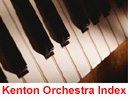Tribute to a Band MastermindLos Angeles Times
|
|
Even in the final years before he died in 1979, orchestra leader Stan Kenton still barnstormed the country, traveling relentlessly between concert halls and college clinics. The travel was mostly by bus, and Kenton frequently rode with his employees. In the 70s, according to one of the last musicians Kenton hired, the bandleaders entourage often included a toy gorilla named Jacob and a bat named Rathbone. Stan had developed a collection of toy rubber animals, said saxophonist Alan Yankee, who joined Kenton in 1975. And unfortunately, if there was a musician with an ax to grind, the toy animals suffered for it. Sometimes, Stan would come back on the bus and find the animals put together in compromising situations. One day, Jacob the gorilla, a particular favorite of Stans, disappeared. Someone wanted to torment him. Stan started getting letters and postcards from all over the world from Jacob. Finally, a few years later, Yankee concluded ominously, Jacob showed up in a shoe box. Yankee, 45, who joined the Kenton band fresh out of the Berklee School of Music in Boston when he was 21, is part of the great tradition of music and touring, Kenton style. Talks with Yankee and other Kenton veterans from four and five decades back reveal constants in the bandleaders personality: He took care of his band members, he had a sense of humor and he was extremely dedicated to the music. One other thing was constant over the years: the bus. The bus became home, said Yankee, who directs the 18-piece Stan Kenton Alumni Orchestra on Sunday at the Irvine Marriott Hotel. We were with each other 24 hours a day for three years. He was physically old and not in the best of health. Its hard to describe him, to come up with a simple explanation for such a complex man. Kenton had played in the dance bands of saxophonist Vido Musso and others before forming his own Artistry In Rhythm Orchestra in 1941 and establishing himself at the Rendezvous Ballroom in Newport Beach. By 1945, with arranger Pete Rugolo designing much of the music, Kenton and company achieved a kind of crossover between pop and jazz, scoring hits with Peanut Vendor, Across The Alley From the Alamo, and Eager Beaver. So its fitting that Rugolo is the guest of honor at Sundays concert. Singers Anita ODay and June Christy also came through Kentons band. Kenton used the financial leverage of his bestsellers to pursue more ambitious projects, beginning in 1949 with his 20-piece Progressive Jazz ensemble and, a few years later, his 43-piece Innovations In Modern Music Orchestra. Both projects were controversial and had little commercial success. He won and lost more fortunes, Yankee said, but he was always more interested in the artistic side of things. Those hits of the 40s made him money, but he turned that money around and did big projects like the Innovations and the Mellophonium orchestras. Yankee promises the orchestra will touch on a variety of Kenton eras and many of the great arrangersBill Russo, Rugolo, Bill Holman and otherswhen it performs Sunday. But the emphasis will be on dance music. Saxophonist Jay Migliori, a member of Sundays Alumni Orchestra who was with Kenton for several months in 1960, remembers Kenton for his great sense of humor. After gigs there was always a lot of drinking and laughing and telling of jokes. And he had more jokes than anybody. Bassist Don Bagley, who anchors the Yankee-directed orchestra in Irvine, joined Kenton in 1950 to play with the Innovations Orchestra. The group was so large it required two buses, given Kentons policy of allowing musicians wives to travel with their husbands. Bagley married in 1951, and his wife joined the family. We had 14 wives on the bus and they had their own network going, he said. They knew what was happening before we did. Someone discovered ghostingpaying for a single room [in a hotel] and sneaking your wife up. Wed check in and be followed up by 14 women, some of them with dogs, trying to sneak into the hotel, Bagley said. They got wise to that pretty fast. Bagley recalled the drinking and camaraderie that went on after concerts, but said not every bus story is happy. One night on the Pennsylvania Turnpike in 1952, a substitute driver fell asleep and rear-ended a truck just pulling onto the freeway. Stan wasnt in the bus that night, Bagley said. When we hit, the entire brass section hit the seat in front of them with their chops. Some of the seats were torn out of the floor from the impact. Only five regulars could do the show in Harrisburg the next night. Most of the guys went home. Stan was concerned with everybody elses welfare rather than his own, and not just from a business aspect, Bagley said. He was a great humanitarian. I never heard him ever criticize anyonearrangers or musicians.
Kenton pursued his style of music even in the face of criticism that it wasnt always jazz and often didnt swing. Of course, the band did swing on the occasions it was called to, Yankee said. But the music had so many other influences, the European classical influences heard in the Neophonic Orchestra or Kenton Plays Wagner. He was open to new ideas. The criticism that Kenton wasnt the ultimate shaper of his music, that his arrangersRugolo, Shorty Rogers, Gerry Mulligan, Neal Hefti and othersprovided the innovations, is misguided, according to Bagley. Stan chose those arrangers, he said. Stan was in control.
|


